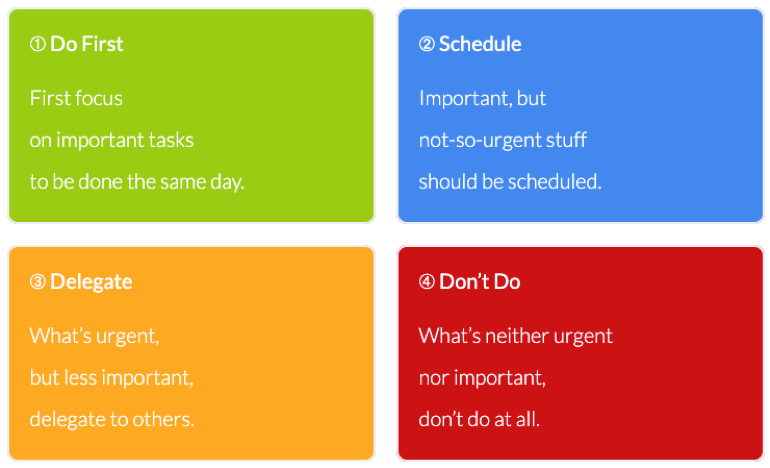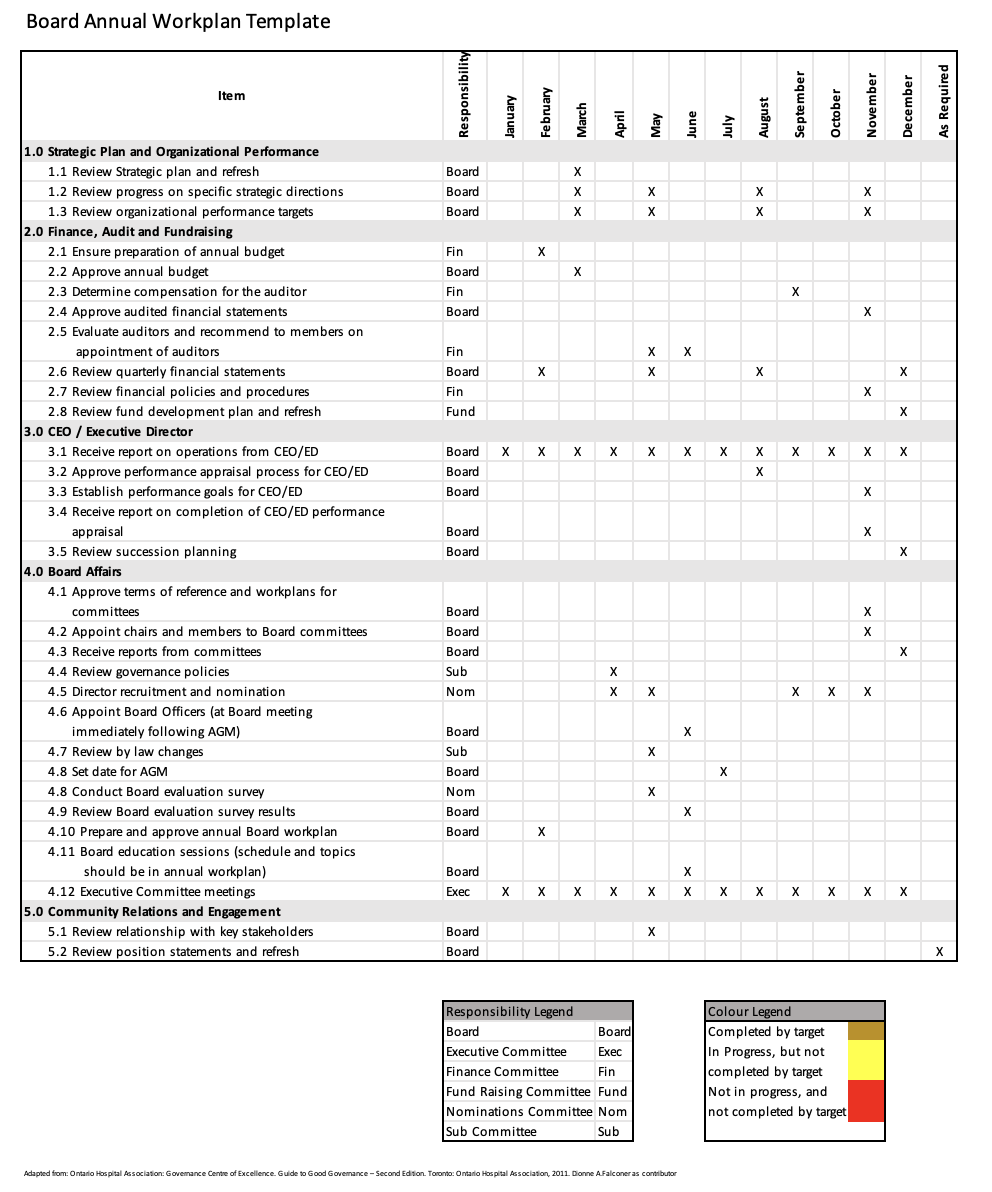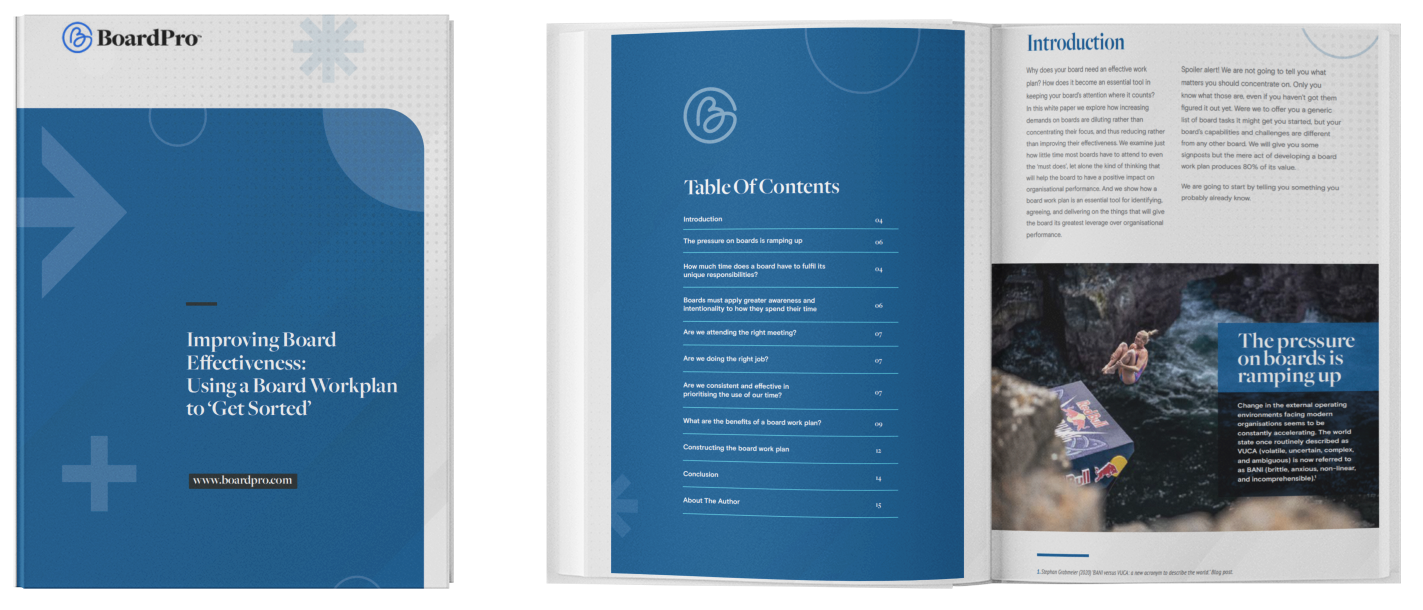Why Your Board Needs An ‘Annual Work Plan’ - FREE Template
Typically, board meetings get distracted by matters of little relevance or consequence.
Demands on governing boards are increasing and with them there is pressure to include more items on board meeting agendas. Examined closely, many of these have little or no governance relevance or consequence. Regardless of content substance, agenda overload typically results in boards dealing only superficially with even those matters that are central to their responsibility to direct and control the organisations they are responsible for.
Boards committees are particularly susceptible to being drawn into short-term, day-to-day operational and management matters. The nature of management reporting is often blamed for this and with some justification. However, the main cause of unproductive board meetings is a lack of thought and intentionality on the board’s part as to where it should best focus its time and attention.
Work Plan Expectations - Important vs. Urgent Matters
Doing the right work and doing it well demands that boards are able to distinguish between matters that are truly important and those that are merely urgent. Most boards need to make a specific effort to ensure that less pressing, but nevertheless important, matters are prioritised and scheduled so they do not get ‘crowded out’. A simple 2 x 2 time management grid is a useful starting point for analysis.

Of course, crises (urgent and important) do arise from time to time but the greater proportion of what is truly board work sits in the ’important but not urgent’ cell of the matrix.
Long Term Planning - The Aims and Objectives of an Annual Board Plan
To be effective a board must have a clear, longer term view of the company and what it will work on
Boards that don’t just operate from one meeting to the next often have what they call a ‘board work plan’. Mostly, however, these turn out to be little more than a schedule of events (dates of board meetings, committee meetings, AGMs, etc.) and when compliance obligations fall due (e.g. Chief Executive performance review).
Getting key dates into directors’ diaries is important but it is not the same thing as ensuring that the board is fully focused and intentional about making the best use of its meeting time. For this a far more comprehensive and effective tool is a twelve-month work plan.

DOWNLOAD FREE ANNUAL PLAN TEMPLATE
A strategic one-year work plan defines, and schedules ahead of time (say for the next 12 months), the two primary categories of the committee's work: the things it should work on (because those will constitute the board’s most valuable contribution to organisational wellbeing) and the things it must do (usually to fulfil legal and contractual obligations) for the year ahead. The work plan should be clear, organised and easy to review.
Benefits of an Annual Board Plan
- Its preparation forces a committee to crystallise its collective awareness of the things to which it must apply quality thinking.
- It forces the board to be realistic about – and prioritise – the time it has available to properly consider operational or management matters of board-level significance. In some cases, the committee might be led to scheduling more and/or longer meetings. In others, it may figure it can meet less frequently or for shorter sessions.
- Scheduling important topics into a strategic work plan agenda generates commitment and perhaps even a sense of urgency to review matters that would otherwise be vulnerable to continual postponement. It lessens the board’s vulnerability to being distracted by whatever is currently top of mind among directors and management.
- Deciding in advance the topics they need to prioritise over a sequence of meetings, creates a starting point for the construction of the agenda for each board meeting. Other potential items, by definition, will be subordinate and should be addressed later in the meeting.
- By taking a more holistic view of the challenges in front of the board the potential interrelationships between different priorities can be seen more clearly and be scheduled in the most useful sequence.
- Compliance obligations must be attended to whether the board assesses them as important or not. A yearly work plan helps the committee to see how those without prescribed dates or deadlines might be spread out over the entire schedule of meetings to occupy the least time possible at any single meeting
- Having reached prior agreement about the board’s priorities makes it more difficult for individuals who would otherwise impose their latest preoccupations on their colleagues. It is easier for others (and not just the chair) to bring them back on task.
- Not least, a strategic work plan for the company helps board committees and management to see what preparation is needed for the coming year – and by when – to support the board’s deliberations. They are better able to plan their actions and deliver their intended results
Preparing an Annual Work Plan and Agenda
The ultimate responsibility for having productive committee meetings sits with the board itself. Meetings are for boards to do ‘governance work’. It can be tempting to leave the initial development of a strategic work plan to the chair or committee or even to management.
Preferably, however, the board committee should be directly involved from the outset in thinking about what would justify its time and attention. A good starting point is a ‘whiteboard’ planning session that promotes discussion of specific goals and testing of ideas from around the table. Key staff should also have the opportunity to contribute to this strategic planning process.
Putting together an initial plan for a year’s work like this immediately invites revision: to get things in the right order; to ensure better distribution of workload through the year; to highlight trade-offs that must be made to make room for something more important, to see what can be handled in a normal board meeting and what should be dealt with via a separate ‘workshop’; to review and see if what the board might be thinking of doing would be better delegated to the chief executive, and so on. For these reasons a yearlong plan is never a static plan.
The planning and preparation of a twelve-month work plan will help a committee to appreciate just how valuable (and scarce) it's time really is. It will prove just how difficult it should be to find time for non-essential tasks.
Share this
You May Also Like
These Related Stories

Improving board effectiveness with an annual work plan

Why board meetings are prone to become 'too operational'



